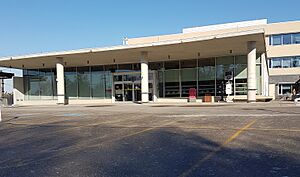CNIB Foundation facts for kids
|
Fondation INCA
|
|

Logo since 2018
|
|

CNIB headquarters in Toronto
|
|
| Formation | March 30, 1918 |
|---|---|
| Type | Charitable organization |
| Registration no. | 119219459RR0003 |
| Headquarters | 1929 Bayview Avenue, Toronto, Ontario, Canada |
|
Staff
|
1,100 |
|
Volunteers
|
10,000 |
|
Formerly called
|
Canadian National Institute for the Blind (1918–2010) CNIB (2010–2018) |
The CNIB Foundation is a Canadian charity that helps people who are blind or have vision loss. It is also a volunteer group that teaches all Canadians about keeping their eyes healthy.
The organization was started in 1918 to help soldiers who lost their sight in the First World War. At first, CNIB gave them a safe place to live and special jobs.
Today, CNIB does much more. It supports research, teaches the public about eye health, and provides training and support. It also has a special library for people who have trouble reading regular print. CNIB is a member of the Braille Authority of North America.
Contents
History of CNIB
The Canadian National Institute for the Blind (CNIB) was officially created on March 30, 1918. Its first mission was to help soldiers returning from World War I. It also helped people who were blinded by the Halifax Explosion in 1917. This event was the largest mass blinding in Canada's history.
Two of the founders were Dr. Charles Rea Dickson and Edwin Baker. The organization began with just 27 employees helping about 1,500 people, mostly in Toronto.
Early Years
In the 1920s, CNIB tried to find jobs for people with vision loss. They also created jobs by opening their own small factories and shops that sold things like brooms. The organization also hired a special nurse to focus on preventing vision loss.
In 1923, a home and school for blind children under six years old was started in Ottawa. It was meant to be a place where young children could get proper care and education. However, it closed after its founder passed away, and the money was given to CNIB.
Growth and Advocacy
By the 1950s, CNIB was helping over 17,000 people across Canada. It had offices, training centers, and homes in major cities. The organization also began to focus more on research to prevent blindness.
CNIB also started to speak up for the rights of people with vision loss. In 1930, they helped pass the Blind Voters Act. This law allowed a person who is blind to have a sighted person help them vote. In 1956, CNIB helped create a course to train blind people to become computer programmers.
In 2010, the organization changed its name to just "CNIB." Then, in 2018, it became the "CNIB Foundation."
What Services Does CNIB Offer?
CNIB offers many services in communities across Canada to help people who are blind or have partial sight. This support can be given at a CNIB office, online, over the phone, or right in a person's home.
Life Skills and Support
CNIB helps people learn important life skills. This includes:
- Daily Living: Learning safe ways to cook, do laundry, manage money, and take care of personal needs.
- Getting Around: Instructors teach people how to move safely around their homes and travel in their communities. This is called Orientation and Mobility training.
- Emotional Support: CNIB offers support groups where people can share their experiences. These groups are often led by staff or volunteers who also have vision loss.
- Using Your Vision: Specialists help people use their remaining sight as much as possible. They can also provide training on how to use special low-vision devices.
Advocacy and Information
CNIB helps people get the resources they need. They can give advice on topics like housing, finances, and finding fun activities.
Library and Technology
CNIB used to run a large library with over 80,000 items in formats like braille, audio, and e-text. This library is now run by a new organization called the Centre for Equitable Library Access (CELA), which was formed in 2014.
CNIB also helps people use assistive technology. This includes devices like audio book players, video magnifiers that make text bigger, and computer screen readers that read text aloud. Specialists can help people choose and learn how to use the right devices for them.
How Is CNIB Organized?
CNIB has about 1,100 employees and over 10,000 volunteers across Canada. These people work in many different areas, including training, research, and fundraising.
The main office is in Toronto, but there are eight divisions for different provinces and territories. A volunteer board of directors, with members from all over Canada, governs the organization. These members include business leaders, doctors, and people who have been affected by vision loss themselves.
Discounts with a CNIB Card
Many businesses and government services offer discounts to people who show a CNIB ID card. This card is for Canadians who are legally blind. This means they have 20/200 vision or less in their best eye (with glasses) or a very narrow field of vision.
Air Travel
Airlines like Air Canada and WestJet have a "One Person, One Fare" policy for flights within Canada. If a person with vision loss needs an attendant to travel with them, the attendant can get an extra seat for free. The attendant only has to pay the taxes and fees.
Train Travel
Via Rail allows one escort or attendant to travel for free with a person who has vision loss. The person must have their CNIB card when they buy the ticket.
Bus Travel
Some bus companies let a guide travel for free when they are with a person who is blind. It's a good idea to contact the bus company to ask about their rules, as they can be different in each province.
Cultural Events
Showing a CNIB card can get you a discount at some cultural events, like movies. Many movie theatres are part of a program called Access2Entertainment. With this program, a support person can get into the movie for free.


